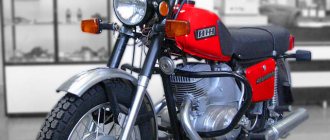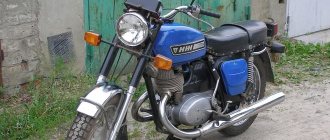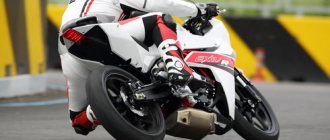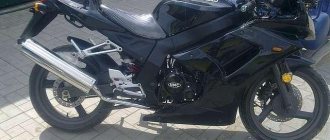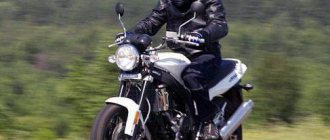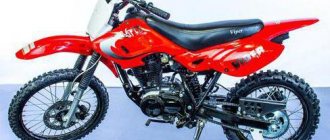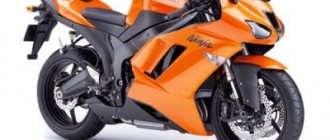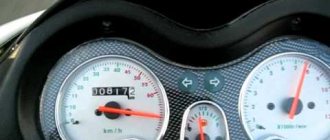Every rider has experienced the agony of choice at least once in his life. After driving a Shadik 750 for two years, then driving a 100 liter for a couple more years, I started thinking about buying something bigger. My wife really liked the Honda vtx 1800 cruiser in the neighboring salon - she works nearby and sells new and used Japanese cars. According to male logic, I initially did not set my sights on such volumes, although my height and weight are quite sufficient to manage the largest cubic capacity.
History of creation
The history of the famous model began in 1995 with the presentation to the general public of the new Zodia concept from the Japanese company Honda. With this motorcycle, Japanese manufacturers sought to enter the American market, quickly conquer it and, to be honest, displace the iconic Harley-Davidson.
The VTX 1800 F cruiser motorcycle was released in 2001 and was immediately recognized as the largest touring motorcycle in the world with a 1.8 liter V-Twin engine. The innovative design of the pistons, also the largest in the world, installed on a motorcycle, brought the concern additional points and high praise in the world.
The new model entered the markets of both America and Europe, but the American direction was still a priority, since sales figures are highest there. Therefore, the cruiser was made in a typically American style under the slogan: “Stand out from the crowd at any cost!”
The Honda VTX 1800 lost the championship to the Kawasaki Vulcan 2000 in 2004.
After the appearance of the basic model in 2001 and its recognition, the concern next year released two more modifications with the indices R and S, a year later - version N, and a year later - F.
The concern stopped producing the motorcycle by 2009.
Main modifications
Technical characteristics, layout and basic design have not changed in all versions. They differ in external details.
So the basic version with the C index has shortened fenders and alloy wheels, a speedometer on the steering wheel and a 2-in-1 exhaust pipe.
Version R – alloy wheels and shortened fenders; S – the wings remain elongated, but the wheels are already spoked; N – new retro style.
The Honda VTX 1800 F motorcycle features wheels with low-profile radial tires on rims made in the form of double spokes, but cast. It has a clock and an LCD tachometer.
Fluke
My initial desire was a Honda VTX 1300 or a Royal Star - Yamaha XVZ1300.
After reading forums and reviews from owners, and listening to my wife’s sighs, I decided to consider other options. A month of online and live communication with chopper owners led me to a choice: a Honda BTX 1800 or a stylish Yamaha XB 1900. The availability of both options on the secondary market in our city left much to be desired. It is clear that you will have to order through sempermoto from Japan or America, so there was not much difference, 1800 or 1900. I didn’t have much experience riding Yamahas, but I knew Hondas very well, but I was more drawn to the unknown. The agony of choice disappeared by itself when my beloved called and said that she had agreed to test drive a Honda vtx 1800 motorcycle in the store.
An unexpected weakness arose inside me when they rolled Vtyks onto the site. A small tremor passed through the palms, and, penetrating the whole body, went into the shoes. Even before I had ridden him, I realized that it was He.
I still remember my first trip, although 4 years have passed. The Honda vtx 1800 seemed to be testing my strength - it was big and heavy, it took turns awkwardly, making me blush under the sealant and sweat in the aisle, where, out of habit, I still drove a couple of times. It was love at one sight, the condition of the bike turned out to be perfect, but the price did not suit me. At home, in the evening, my wife and I discussed loan options for the missing amount, but then a call came from Yekaterinburg - a buyer had been found for Shadik. Fate itself was on our side. Sorry Yamaha xv, see you later!
The formalities are over, the Honda vtx 1800 is in my garage, the technical specifications have already been memorized, the routes for long runs have been laid out, we are waiting for spring, we are rolling in little by little.
Model description
Structurally, the model is no different from other Japanese choppers and cruisers. The frame is made of durable, practically non-deformable steel pipes, a high-tech engine, liquid cooling and a cardan shaft as the main drive. In general, practical and super reliable.
The weight of an empty motorcycle is more than 320 kg, and a full one is almost 350 kg. Not even every man can cope with such a colossus, especially in city traffic jams, at low speeds, and we’re not even talking about girls. Moreover, he maneuvers extremely leisurely. Experienced drivers confirm that the large and wide Honda VTX 1800 motorcycle is not intended for jumping from row to row. The panniers (leather, by the way) have to be removed if there is a need for frequent trips around the city. And change the steering wheel to a narrower one too. Only then can you drive between the rows in order to be the first to take off at a green traffic light and go far ahead of those who were standing behind or next to you.
But the VTX 1800 was not intended for traveling around big cities. His element is good roads and high speeds; he can easily reach a maximum speed of 200 km/h.
A large motorcycle does not look bulky. Maybe because everything in it is proportional and organic. Its dimensions (LxWxH) are 2.4x0.9x1.1 m. Seat height is 0.7 m, ground clearance is 0.13 m, wheelbase is 1.7 m.
The load on a motorcycle can also be considerable. The total weight of the driver, passenger and luggage can reach almost 200 kg.
000_MOTO_1110_030
Honda VT1300CXA Fury: custom, 2010, 1312 cm³, 58 hp, 600,000 rub.
Honda VT1300CXA Fury: custom, 2010, 1312 cm³, 58 hp, 600,000 rub.
No, initially no one doubted that the product from Honda would be viable, but it’s one thing to hang a “custom” motorcycle with almost classic geometry and “stick” into it a universal engine that was used on everything from enduro and cruisers to roadsters and tourers (as was done, for example, with the NV750 aka VT750 series), and another thing is to build the right custom, in compliance with all (or almost all) style canons, and at the same time “teach to ride” this miracle with a fork angle of 45 degrees, achieved, however, due to a fantastic correction angle of 13 degrees (the installation angle of the feathers relative to the axis of the steering column), an actual “rack” of 32 degrees and a “two hundredth” rear balloon (for more details on the technical part, see “Moto” No. 5, 2010 ). Of course, by the word “drive” I mean not just the ability to move in space, but also handling, acceleration and braking dynamics, ergonomics - in general, everything that custom cars, choppers and other cruisers don’t particularly “suffer from.” In general, at Honda, caring for people is one of the main design principles, unlike many other manufacturers who make motorcycles for the track, for picking up girls, for off-road... Honda always makes motorcycles, first of all, for the pilot, and only secondly for something. Actually, the story with Fury only confirmed this.
My entire life experience literally screamed to me that such a “steam locomotive”, with such a base, wheel size and fork angle, should be able to do only one thing well - growl nobly and sparkle with chrome, well, maybe even drive in a straight line. But Fury broke through the callousness of consciousness with the ease of a pound weight falling on a chicken egg! Three hundred kilograms of curb weight on the move is absolutely docile and predictable. The motorcycle does not break in turns, like the overwhelming mass of its classmates, does not resist the will of the pilot when trying to turn off a straight line, it simply does what is required of it at the moment. Perhaps the only family problem that could not be avoided is the small angle of inclination in corners. Lay it a little deeper and you’re already drawing the “anchor” of the running boards on the asphalt. At the same time, the reserve of the rubber profile, “holder” and chassis rigidity would easily be enough for another 10-15 degrees, but - alas and ah! — you can only turn slowly and sadly. Well, or change the “anchors” of the footrests once a month. In general, while driving this device, distracted by my own thoughts and glances from passing cars, I kept forgetting that I was still on a custom bike, and quite a radical one at that, because the ease of control, nimbleness and obedience of the motorcycle would be more suitable some quite fresh “classics”.
Traffic jams are a serious test for any motorcycle. The ability for daily use, you see, is an important factor when choosing a device. It was this discipline that caused me serious skepticism before the test, but the brilliant way Fury passed this test finally convinced me that Mr. Soichiro Honda’s office employs people exclusively with a magical education. The long and low “locomotive” cut through the capital’s traffic jams so easily and simply that sometimes it was even necessary to disperse unready sportbikers from the “between aisles.” If you try to summarize all the driving impressions, it can be done in one word - lightness. The motorcycle is easy to ride in the full sense of the word. It does not require any effort from the pilot. Driving a Fury is a relaxation, even in Moscow sweltering from the abnormal heat, even in traffic jams, even on not very good asphalt.
Yes, the suspension travel is almost sportbike travel: only 102 mm in the front and 95 in the rear. But even with such meager moves, even taking into account the fork angle, the suspension conscientiously handles all the irregularities. Of course, you shouldn’t go over speed bumps, and at high speed sometimes the back end comes off the saddle, unable to keep up with the “used” suspension, but the overall level of comfort is more than acceptable. This characteristic is achieved due to the “steep” suspension progression curve. That is, simply put, the suspension becomes noticeably stiffer with every millimeter of travel. I will say this: for almost a thousand test kilometers, not a single breakdown occurred, and my beloved spine never made even a timid attempt to crumble the well-known item of underwear.
But the passenger on the Fury is not at all as comfortable as the pilot. The true-chopper “slapper”, proudly called the “passenger seat”, is, of course, consistent with the canons of style, and it seems like the “correct” girlfriend of a biker should feel great even on a bare wing - remember the end of the film about Harley Davidson and the Marlboro Cowboy. But that’s a movie, but here it’s the truth of life. My companion, who traveled with me for thousands of kilometers on completely different motorcycles, rode as a passenger on a Fury for twenty kilometers, said that the name of the motorcycle was chosen absolutely accurately, switched to her own and refused to ride “pretentious and fat” on a “cool chopper” flatly. By the way, things are about the same with attempts to “ride” your own belongings on Fury. The clean lines of the “tru-chopper” completely excluded the possibility of placing not only a backpack, but even a modest string bag in the passenger seat. The eternal luggage savior of a motorcyclist - there is simply nothing to hang on to the luggage net! There are no special brackets for attaching luggage or, at worst, elements of the subframe under the rear wing, to which the spider’s hooks could be hooked. You can, of course, “catch” on the wing itself, but it is plastic, and if it doesn’t break, the paintwork will be damaged. So for long distance travel, only with a backpack on your back.
By the way, about “long-distance vehicles”. The second surprise from the motorcycle after handling is wind protection. On a completely “naked” custom, where only the dashboard body the size of two cigarette packs has an “aerodynamic” shape, it doesn’t blow away! This is truly obvious and incredible. The motorcycle allows you to maintain a cruising speed of 140–150 km/h, and at the same time the oncoming flow does not “tear your head off”, but does not annoy you at all, at any speed remaining at the level of “the wind of freedom blowing in your face.” How Honda engineers were able to achieve such aerodynamics will forever remain a mystery to me. The “obvious improbability” is also complemented by the fact that even at a speed close to the maximum, the oncoming flow does not rip your legs off the pegs and does not “spread” your knees, which is what almost all “chopperoids” suffer from. Returning to the issue of handling, but in a highway format, I note that the chassis rigidity and handling resource are more than enough even for very fast driving, and thanks to the long wheelbase and large fork angle, the motorcycle, traditionally for choppers, has excellent directional stability and stability even on a not very high quality surface. Overall, it turns out to be quite a “long-range” device. It’s fast, not tiring, and comfortable, but you’ll have to travel either alone, with a backpack on your back, or with a passenger and a thick wallet in your pocket, so you can buy everything you need right along the way.
High speeds require high-quality brakes! The test vehicle is equipped with optional ABS with combined braking system. The three-piston floating caliper at the front, familiar to us from the VTX family, despite its solidity, turned out to be practically useless. A wheel placed far forward with a very modest contact patch is practically not loaded, and therefore every now and then it tends to skid. A couple of times, until I realized that it was better to forget about the lever on the steering wheel, ABS saved the day. By the way, the safety-free version of the Fury has a more modest two-piston floating caliper installed at the front. Despite the difference in the number of pistons, the brakes are essentially identical, it’s all about the same “combi-brake” on the version with ABS. From the front brake lever, only the two outer pistons of the front caliper are activated, and from the pedal, the entire rear caliper and the middle piston of the front caliper are activated. The situation with the brakes is completely “pulled out” by the rear circuit. The “two hundredth” cylinder has a huge contact patch, and in addition, almost the entire weight of the motorcycle and rider is concentrated on it, so at any speed, the motorcycle stops in about the same way as if an anchor weighing a couple of tons!
Motorcycle engine
The engine is the main feature of the VTX 1800 motorcycle. It is a two-cylinder V-twin, liquid-cooled, six-valve, electronic fuel-injected, 2-liter engine. Produces power of 107 hp. With. and torque 164 Nm. And in appearance it is quite large. Even without knowing the capabilities of the motorcycle, you can guess from the look of the engine that they are large, despite the fact that the cardan drive takes away some of the power. The actual power of the motorcycle is up to 80 hp. With.
At maximum power, the engine spins 5000 rpm, and at maximum torque – 3000 rpm.
Finned cylinders maintain the overall conservative class style, while the fins also dissipate heat.
Other important characteristics of the Honda VTX 1800 are acceleration to hundreds of kilometers per hour in just 4 seconds, and fuel consumption per 100 km - 6.5 liters. True, this is official data. Motorcycle owners raise this limit to 7-8 liters, stipulating that less is possible, but with careful driving without cargo or passengers. Just who will drive such and such a vehicle quietly and calmly!
Video
Honda VTX 1300
- a motorcycle that always stands confidently on the road. Being the youngest in the VTX line, it is, of course, inferior in performance to its older brother, equipped with a 1.8-liter engine, but, nevertheless, 1300 cc. see, as practice has shown, it is quite sufficient for any purpose. An interesting fact is that despite the fact that the Honda VTX1800 and VTX1300 are very similar in appearance, their engines are completely different. Simply put, the engine of the 1300 cc version was developed specifically for this motorcycle, and is not based on the 1800 cc engine. The model was produced from 2001 to 2009, after which it was replaced by the Honda Fury. There were four different versions of the motorcycle - C, R, S, T, which differed from each other in body kit elements and, as a result, in weight. All modifications were equipped with a 5-speed gearbox, one carburetor, a cardan wheel drive and a V-shaped liquid-cooled engine producing 75 horsepower and 123 nm of torque. The engine loves low speeds, delivering its maximum already at around 3000 rpm, and thanks to it the VTX 1300 is a very dynamic cruiser, despite its solid dimensions and impressive dry weight (about 300 kg).
Speaking of sizes, they really command legitimate respect. This motorcycle is not intended for fragile, graceful girls or puny bikers, no, its typical owner is a strong man, confidently moving three hundredweight of Japanese steel. The Honda VTX 1300 stands powerfully on the road, supported by impressive wheels, its element is not city streets clogged with cars, but wide and spacious highways, where it can reveal its full potential. Of course, you can drive a VTX around the city, people do, but this mastodon doesn’t feel very confident in a narrow aisle. But as soon as you get out on the highway and turn the right handle towards you, you immediately understand why so many people love this motorcycle so much. Thanks to the low center of gravity, the VTX1300 does not seem subjectively as heavy as it actually is, but when you have to push it uphill with your feet after parking poorly, you immediately understand where all its kilograms have gone. On the move, however, the situation changes for the better, although the motorcycle does not like sharp maneuvers at all. At speeds above 120-130 km/h, the VTX 1300 generally changes its trajectory imposingly and reluctantly, and this requires a lot of effort.
With a top speed of 200 km/h, the VTX 1300 accelerates from 0 to 100 km/h in 5.5 seconds, according to official figures. Not so fast, even by the standards of cruisers, but it does not “deflate” after 100-120 km/h, continuing to confidently pick up speed. Braking is handled by a system of three disc brakes, with two-piston calipers at the front and a single-piston at the rear. In general, we can say that there are enough brakes for normal driving, but they may not be enough if emergency braking is necessary, so many owners prefer to upgrade the brakes by installing, for example, reinforced brake hoses. As for the chassis, the Honda VTX 1300 is a typical large cruiser. A steel frame, low ground clearance, fairly short-travel, but not too stiff suspensions - everything is according to the canons of the genre. The free play of the rear shock absorbers is less than 9.5 cm, and, nevertheless, this does not bring any discomfort to the ride, perhaps partly due to the comfortable and moderately soft standard seats, somewhat reminiscent of those on the Yamaha Midnight Star 1300.
Some people like to compare the VTX 1300 with its 1800 cc version, reproaching the younger brother for its more modest characteristics compared to the older one. Well, this is partly true - with comparable weight and similar dimensions, the VTX1800 is much more powerful. But at the same time, it is more expensive and more voracious, while the 1300 cc engine consumes about 7 liters per hundred during quiet driving, and the 18-liter gas tank is enough for quite long trips. Be that as it may, the VTX 1300 should not be recommended to beginners - it is too powerful, huge and heavy.
Chassis
If we talk about the basic version of the Honda VTX 1800 C, the front tire size is 130/70 R18 and the rear tire size is 180/70 R16.
The front suspension is a 45mm inverted telescopic fork with a 32° caster and 130mm of travel.
The rear suspension is a double shock absorber with five-stage preload adjustment and 100 mm of travel.
The brake system is combined hydraulic and consists of a double disc with a diameter of 298 mm, a thickness of 4.5 mm, a three-piston caliper with metallized brake pads, and a rear disc with a diameter of 316 mm, a thickness of 7 mm, a two-piston caliper, again with metallized brake pads.
This number of discs allows when you press the rear brake pedal, not only the rear, but also one front disc is activated. At the same time, it is impossible to brake before skidding, according to experienced bikers, since the force on the pedal is quite high.
Specifications
| Model | Honda VTX 1800 |
| Motorcycle type | cruiser |
| Year of issue | 2001-2008 |
| Frame | steel |
| engine's type | 2-cylinder, 4-stroke, V-shaped |
| Working volume | 1795 cc cm. |
| Bore/Stroke | 101 mm x 112 mm |
| Compression ratio | 9,0:1 |
| Cooling | Liquid |
| Number of valves per cylinder | SOHC, 3 valves per cylinder |
| Fuel supply system | electronic injection PGM-FI |
| Ignition type | digital |
| Maximum power | 107 hp at 5000 rpm (89 hp - at the wheel) |
| Maximum torque | 163 Nm at 3000 rpm (134.1 - at the wheel) |
| Transmission | 5-speed |
| type of drive | cardan |
| Front tire size | 130/70 R18 (C-version) |
| Rear tire size | 180/70 R16 (C-version) |
| Front brakes | 2 discs 298 mm, 3-piston calipers (combined) |
| Rear brakes | 1 disc 316 mm, 3-piston caliper (combined) |
| Front suspension | 45mm inverted fork, 130mm travel |
| Rear suspension | double shock absorber (preload adjustment), stroke - 100 mm |
| Acceleration to 100 km/h | 4.1 sec |
| Maximum speed | 201 km/h |
| Gas tank capacity | 15.5-20 l (depending on version) |
| Motorcycle weight (curb) | 343-361 kg (depending on the version: C - the lightest, N - the heaviest) |
Fuel consumption
The average official fuel consumption for the Honda VTX 1800 is 6.5 liters per 100 km. The actual consumption value, according to reviews from owners, is 7-8 liters.
Engine
The engine of the VTX 1800 is four-stroke and two-cylinder. This unit is V-shaped in shape. Its effective volume is 1795 cm³. The engine is liquid cooled and the fuel supply system is injection.
When reaching 3500 rpm, the engine produces 162.7 Nm of maximum torque. At 5000 rpm the engine produces 106 hp. maximum power. The maximum speed here is 189 km/h, and the motorcycle will accelerate to 100 km/h in just 4.8 seconds.
Transmission
The VTX 1800 is driven by a reliable cardan. The gearbox consists of five stages. This transmission is perhaps optimally suited for this type of motorcycle. It copes well with the engine, the chassis of the bike, and its dimensions.
Dimensions and weight
The model weighs a lot - as much as 359 kg including fuel. The seat height here is average – 695 mm, and the wheelbase – 1715 mm. The bike is 1155 mm high, 990 mm wide, and 2630 mm long. Its gas tank has a volume of 20 liters, which is very decent. Average fuel consumption per 100 km of road is approximately 7 to 8 liters.
Chassis and brakes
The tubular frame is made of durable steel. The exterior of the VTX 1800 is truly majestic. It doesn't have the fussy bombast of many other cruisers. No, this is a real classic of the genre, a lot of chrome elements, neat and sophisticated outlines. The steering wheel, of course, has standard dimensions and shape, and the wheel rims are cast.
The pendulum suspension at the rear is equipped with two shock absorbers. Its stroke is 100 mm. The front suspension is represented by a telescopic fork, the dimensions of which are 45 mm. Its stroke is 130 mm. The rear brake is represented by a 316 mm disc and a two-piston caliper. At the front there are two discs, 296 mm each, assisted by three-piston calipers.
Motorcycle gearbox and electrical system
The gearbox of the Honda VTX 1800 motorcycle is five-speed, multi-disc oil clutch, hydraulically driven. The final drive is an enclosed driveshaft with a 3.091 (34/11) gear ratio.
The motorcycle is equipped with a twelve-volt battery with a capacity of 18A*h and an alternating current generator with a power of 400 W. And the resulting electricity is spent on lighting, one lamp with a power of 55 W for low beam and 60 W for high beam. By the way, many pilots complain about poor road lighting and install xenon not only for beauty.
The starter also consumes electricity; it is electric. The ignition system is digital transistor, computer-controlled with electronic ignition timing control. There are four spark plugs - two for each cylinder.
011_MOTO_1110_030
All driving impressions can be summarized in one word - lightness.
The motorcycle is easy to control in the full sense of the word, requiring no effort from the pilot. Riding the Fury is pure relaxation! All driving impressions can be summarized in one word - lightness. The motorcycle is easy to control in the full sense of the word, requiring no effort from the pilot. Riding the Fury is pure relaxation!
Optional equipment
On the Honda VTX 1800 cruiser, a backrest trunk and voluminous side cases are the most necessary attachments. And the passenger can sit comfortably on a long journey, and there is somewhere to place luggage.
And in order not to get bored, you need to install a music system. For example, the radio is installed on the steering wheel, the speaker system is installed in special podiums on the footrests and in the trunk on the sides of the rear seat back, and the amplifier is in the trunk.
Protection from headwinds is important for the driver, because at such speeds it is strong, and its gusts can throw small debris in the face. Therefore, a high windshield is installed, which also relieves the driver of the stress of resisting the dense air flow.
Motorcycle tuning
What might be interesting about this motorcycle is the tuning. The Honda VTX 1800 really asks for the implementation of design projects that emphasize the American character of the Japanese motorcycle.
This can be airbrushing, which gives the silhouette additional swiftness or predatoryness, or painting in exclusive colors, which makes a noticeable car even more noticeable even at night, if you add glow-in-the-dark components to the varnish.
According to the owner’s taste, body kits and other elements made of composite materials or coated with chrome can be installed.
Motorcycles from Japan, as a rule, come off the assembly line carefully thought out to the smallest detail, but nevertheless, experts still find something to improve.
Motorcycle workshops offer to replace the rear wheel with a wider one - 240-250 mm. At the same time, you can install tuned wheels, a metal rather than plastic wing, and progressive shock absorbers. Honda VTX 1800 with such progressive shocks looks wider and more powerful, and it rides more pleasantly. They are shorter than standard ones and can vary in rigidity.
Test drives
Experienced bikers who have something to compare with note the unusually intense acceleration of the American-style motorcycle. In fact, it accelerates to 100 km/h in 3.8 seconds, less than what the manufacturer claims.
You need to adapt to the wide steering wheel, but such a large base itself stabilizes the car during sharp acceleration. On the VTX 1800 you can accelerate to 210 km/h, but without the protective high glass this pleasure is below average, it seems that your hands can come off the steering wheel, and your legs in sailing trousers will be blown off the comfortable footrests.
At cruising speed the motorcycle is stable and stable, which also has its drawbacks. If an obstacle arises, it slowly moves away from the trajectory, which can be downright dangerous for a less experienced pilot.
Short gears, which seem like a disadvantage to many, actually provide maximum acceleration intensity.
During testing, pilots noted the absence of a tachometer, which appeared only in the latest versions; inability to accurately adjust rear view mirrors; uncomfortable, very wide handles lowered down and American-style footrests.
Disadvantages of a motorcycle
There are a few of them, and one of the most noticeable is a slight delay if you suddenly open the gas. Actually, this drawback is inherent in all motorcycles with a cardan drive, but not so noticeable.
The gas tank, which is not large enough for a huge car, also causes some inconvenience. Motorcycle pilots note that with such a low ground clearance it is inconvenient to take turns. You have to do this very carefully, at least until you develop certain skills in driving a heavy motorcycle.
Many people write that a five-speed gearbox is not enough for such an engine. The sixth stage is clearly not enough.
Advantages of a motorcycle
Installing a cardan drive instead of a chain drive is a positive thing, since this design does not require frequent maintenance.
Like all motorcycles from Japan, at least from the Honda concern, the VTX 1800 is distinguished by the precise operation of the gearbox. The big plus is the long engine life. And it only starts making unpleasant noise at high speeds.
With such a powerful engine, parasitic vibrations are practically absent.
According to the comments of happy owners, the appearance of the motorcycle with plenty of chrome and solid finishing gives them no less pleasure than riding on a good track.
The quality not only in the main components, but also in the small details of the Honda VTX 1800 motorcycle deserves a superlative degree.
For whom
Here are the main advantages of the bike:
- monumental exterior with an abundance of chrome surfaces;
- enormous traction, which is felt from the very first seconds of control;
- the highest quality of both main components and small parts.
The bike is not suitable for beginners. The car will feel good and delight the owner if it falls into experienced hands capable of masterfully driving this high-speed monster. With all its advantages, this is far from the best option for uneven roads, because the front suspension travel is small.
Owner reviews
Owners confirm in their reviews that the motorcycle is intended for long roads. It has a hard time with side cases and arches in traffic jams, and on unpaved, especially wet, if I may say so, roads, it does not drive very confidently.
On a Honda VTX 1800 motorcycle, owners determine fuel consumption empirically. Maybe that’s why the difference in readings is large, or maybe the conditions are different: the quality of the road surface and gasoline, the size of the load, speed, the number of accelerations and braking. For some, a full tank of 16 liters is enough for only 200 km, while others claim that 18 liters can travel 300 kilometers or more.
On long trips it becomes clear why the type of motorcycle is a cruiser. On the highway at a speed of 160 - 170 km/h you can drive more than one and a half thousand kilometers in a day.
In general, the reviews are full of emotions, reaching the point of admiration and admiration for the mighty iron horse. There is no negativity at all. Minor comments regarding the absence of some instruments and the inconvenience of landing are eliminated by the availability and quality of components and elements that can replace the standard equipment.
Cool, powerful, reliable, with comfortable ergonomics, the Honda VTX-1800 motorcycle, despite emerging competitors, still occupies the hearts and thoughts of lovers of motorcycle travel. Those who are not afraid of terrifying size and high speeds, who love adrenaline and prefer to tame a strong beast...
